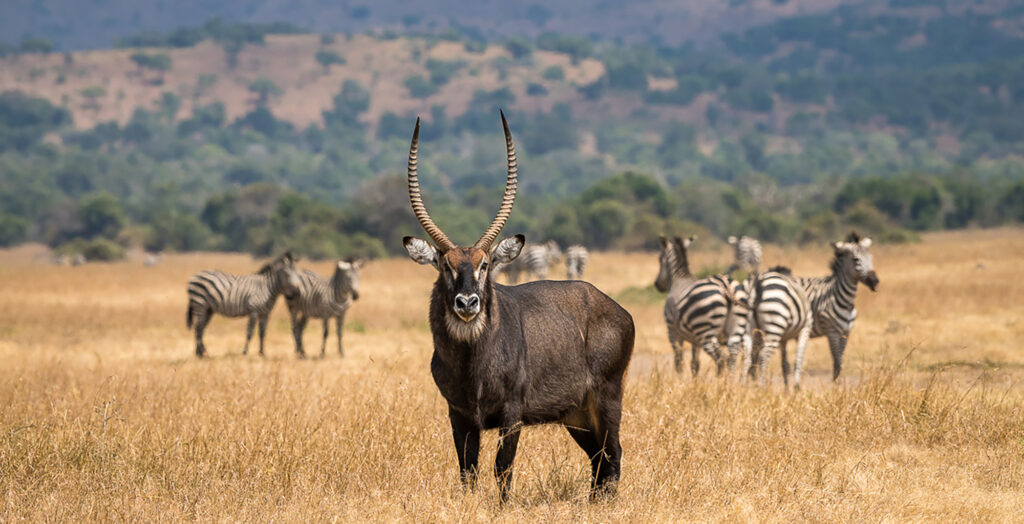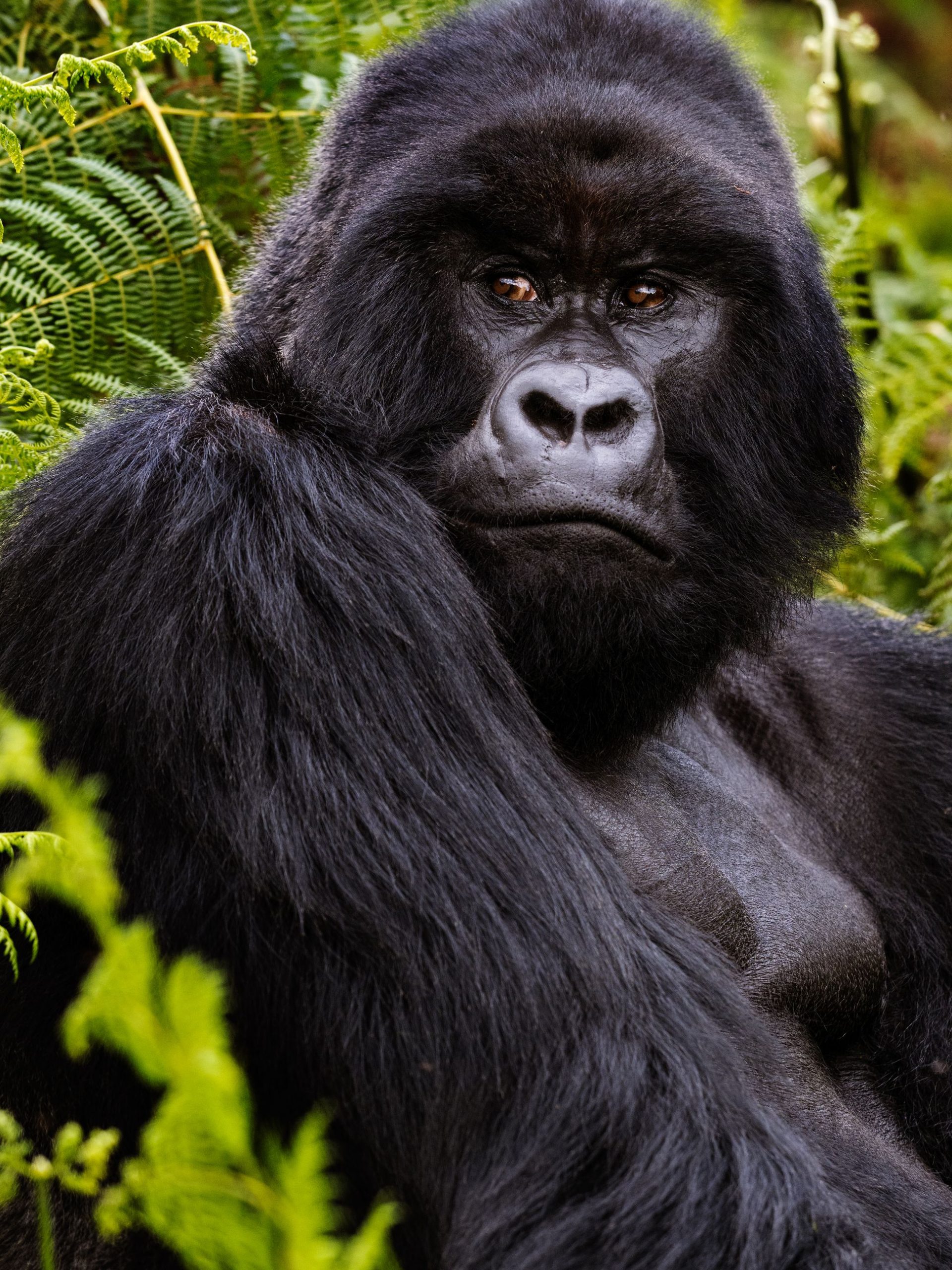
Akagera National Park is a popular tourism destination and an impressive national park situated in the eastern part of Rwanda and covers about 1122 km2 of the total surface area dominated by low mountains, woodland, swamps and savannah. The popular park carries pride as the largest protected wetland in Central Africa and home to the big five mammals which include lions, leopards, buffaloes, elephants and rhinos.
The park is one of the biggest and oldest national parks in the country and offers the most remarkable wildlife viewing experiences. Right in the heart of Akagera lies Lake Ihema one of the key features in the park making it a centre for boat cruising activities while on Rwanda safari tours.
Initially, the park was a rich biodiversity forest reserve and very rich in flora and fauna before being gazetted as a national park in 1934 by the Belgian government.
The major purpose of gazetting Akagera was to ensure the proper safety of the wild animals away from external threats like poaching and other illegal wildlife activities. The aftermath of the tragic Rwandan genocide largely affected the park through illegal settlements and the killing of the park’s wild animals.
A huge number of wild animals including wild dogs, lions and rhinos remained a distance from the park until around 2009 and 2010 when the park was put under the leadership of Akagera Management Company (AMC) later introduced about 7 lions in Akagera before another introduction of about 18 black rhinos from South Africa. in 2019, the longest translocation from Europe to the African continent took place where about 5 more rhinos were translocated from Czech Republic to Rwanda.
About Akagera National Park
Akagera National Park is a popular tourism destination and an impressive national park situated in the eastern part of Rwanda and covers about 1122 km2 of the total surface area dominated by low mountains, woodland, swamps and savannah. The popular park carries pride as the largest protected wetland in Central Africa and home to the big five mammals which include lions, leopards, buffaloes, elephants and rhinos.
The park is one of the biggest and oldest national parks in the country and offers the most remarkable wildlife viewing experiences. Right in the heart of Akagera lies Lake Ihema one of the key features in the park making it a centre for boat cruising activities while on Rwanda safari tours.
Initially, the park was a rich biodiversity forest reserve and very rich in flora and fauna before being gazetted as a national park in 1934 by the Belgian government.
The major purpose of gazetting Akagera was to ensure the proper safety of the wild animals away from external threats like poaching and other illegal wildlife activities. The aftermath of the tragic Rwandan genocide largely affected the park through illegal settlements and the killing of the park’s wild animals.
A huge number of wild animals including wild dogs, lions and rhinos remained a distance from the park until around 2009 and 2010 when the park was put under the leadership of Akagera Management Company (AMC) later introduced about 7 lions in Akagera before another introduction of about 18 black rhinos from South Africa. in 2019, the longest translocation from Europe to the African continent took place where about 5 more rhinos were translocated from Czech Republic to Rwanda.
GAME DRIVES.
Game drives in Akagera National Park are a major tourism activity given the park’s enormous size and several natural endowments including the big five mammals and several bird species including the rare shoe bill.
While at Akagera National Park, visitors are allowed to engage in remarkable game drive experiences that are done in two sessions including the one that starts in the morning around 6:00 am and the last evening one that commences at 6:00 pm where visitors will have an opportunity to sight nightly animals including lions, leopards, civets and serval cats.
Choosing the right tour guide for a game driving experience in Akagera gets almost half of the job done as visitors will be able to get to the most fascinating spots for wildlife. Game driving takes about 1 to 3 full hours depending on the nature of driving trails and weather.
BOAT CRUISING ON LAKE IHEMA.
Boat cruising in Akagera allows visitors to cruise on the fresh waters of Lake Ihema while in the heart of the vast beautiful park. Boat cruising activities in the park are done in four sessions including the first one in the morning which commences about 7:00 am and 9 am and the last two at 3 and 4 pm where visitors can expect to have the most remarkable views of aquatic animals like crocodiles and hippos.
Akagera National Park is one of the most visited tourism destinations in Rwanda and now accessing the park is quite easier as a result of improved infrastructure by the Rwandan government. Situated in the Eastern part of Rwanda, one can start their safari journey to Akagera from the Capital city of Kigali which is about 110km to the destination.
It takes about 2 hours and 30 minutes from Kigali to Akagera by road means of transport and the journey is filled with remarkable wildlife experiences. One can head as though they are going to the Kigali International Airport and just before they are about to reach the airport, a left turn can be taken to Rwamagana up to Kayonza before turning right to Kabarando town.
One is almost at the destination once they hit Kabarando as they can take a left turn onto the Rwinkavu junction where a signpost to the Akagera National Park can be seen.
Akagera National Park is an all-year tourism destination and the park can be visited throughout the whole year although the best time to visit Akagera is during the dry season of the year. The dry period of December to February and June to September stands as the best time to visit the vast park.
Unlike the rainy season, the game drives in the Akagera during the dry season are less stressful and visitors at the park can expect to have the most spectacular views due to the reduced vegetation of several mammal species as a result of reduced and short vegetation including buffaloes, elephants, giraffes, crocodiles, bushbucks, zebras and a wide range of different bird species.
The trails are accessible and not slippery during the dry season making it easier to maneuver through and have an ultimate wildlife viewing experience at the park.
Our Partners
Uganda Tourism Board
.
Uganda Wildlife Authority
.
The Buhoma Gorilla Camp
.
The Bwindi Kids Charity
.
What our customers Say ?
ExcellentBased on 21 reviews
 Headspun2023-07-16Unforgettable Rwanda Emerald tailored our 5 day trip to Rwanda to all our many and frequently changing requests without any fuss. Chris, our driver/guide for the duration, could not have been more helpful and professional
Headspun2023-07-16Unforgettable Rwanda Emerald tailored our 5 day trip to Rwanda to all our many and frequently changing requests without any fuss. Chris, our driver/guide for the duration, could not have been more helpful and professional Nic2022-10-25Amazing holidays! Great holidays! Even my special wishes were included into the planning although time was short. Our guide and driver City Tyson Magezi was caring and responsible. We traveled for four weeks and stayed in different accommodations from hut to tent to amazing hotels.
Nic2022-10-25Amazing holidays! Great holidays! Even my special wishes were included into the planning although time was short. Our guide and driver City Tyson Magezi was caring and responsible. We traveled for four weeks and stayed in different accommodations from hut to tent to amazing hotels. Susanne2022-08-19Just amazing It felt so safe and comfortable and exciting to travel with emerald. Our guide was so caring, so experienced and always friendly and an a great mood. He showed us so many animals included lions and leopards. That was just amazing . We saw wonderful landscapes like waterfalls and had contact to people . No Uganda or Eastern Africa without emerald . I m deep in love with Uganda and will come back as soon as possible.
Susanne2022-08-19Just amazing It felt so safe and comfortable and exciting to travel with emerald. Our guide was so caring, so experienced and always friendly and an a great mood. He showed us so many animals included lions and leopards. That was just amazing . We saw wonderful landscapes like waterfalls and had contact to people . No Uganda or Eastern Africa without emerald . I m deep in love with Uganda and will come back as soon as possible. Jose Murta2022-05-13Memorable Family Trip in Uganda Fantastic Trip that exceeded our expectations! Travelled to Uganda with wife and 2 children (9 and 10y old) for 7 days. Since the start (at planning stage) got a great support from Bob (company owner) and Edmund (our guide) via WhatsApp. They tailored a program to our needs including the unforgettable mountain gorillas hike, general hikes to waterfalls, safari including boat trip to see hipos!! Edmund, our guide, always super polite and the kids enjoyed him a lot! All our hotels, meals included in the package so no hassle on this….we just paid for drinks! The only regret I have is not staying one extra day in the Mburo National Park to explore a bit more ;) Memorable trip with so much nature and a super-humble people that made the experience even more enjoyable!! Super recommend!! The whole family just feeling we need to get back to explore more ;)
Jose Murta2022-05-13Memorable Family Trip in Uganda Fantastic Trip that exceeded our expectations! Travelled to Uganda with wife and 2 children (9 and 10y old) for 7 days. Since the start (at planning stage) got a great support from Bob (company owner) and Edmund (our guide) via WhatsApp. They tailored a program to our needs including the unforgettable mountain gorillas hike, general hikes to waterfalls, safari including boat trip to see hipos!! Edmund, our guide, always super polite and the kids enjoyed him a lot! All our hotels, meals included in the package so no hassle on this….we just paid for drinks! The only regret I have is not staying one extra day in the Mburo National Park to explore a bit more ;) Memorable trip with so much nature and a super-humble people that made the experience even more enjoyable!! Super recommend!! The whole family just feeling we need to get back to explore more ;) Dwayne B2022-05-13Great Experience With Emerald!! It was an amazing experience! My guides Lucky and Hillary made me feel as if I was family and took care of everything I needed. They were very knowledgeable as we trekked to gorillas in Bwindi and a ride a wildlife safari through Queen Elizabeth. I learned so much from them about the animals, the terrain and the surrounding people. They we also incredibly helpful in helping me find activities around Buhoma, where I stayed, all of which were great. By the time I left I knew I had made friends who I will continue to stay in touch with. Can’t wait to come back with my family!
Dwayne B2022-05-13Great Experience With Emerald!! It was an amazing experience! My guides Lucky and Hillary made me feel as if I was family and took care of everything I needed. They were very knowledgeable as we trekked to gorillas in Bwindi and a ride a wildlife safari through Queen Elizabeth. I learned so much from them about the animals, the terrain and the surrounding people. They we also incredibly helpful in helping me find activities around Buhoma, where I stayed, all of which were great. By the time I left I knew I had made friends who I will continue to stay in touch with. Can’t wait to come back with my family! Dávid B2022-05-12Feeding python - 9 lions on a tree - leopard vs. lion We saw all animals and extremely special situations in a short period of time, good organization and friendly guide Paul with lots of knowledge.
Dávid B2022-05-12Feeding python - 9 lions on a tree - leopard vs. lion We saw all animals and extremely special situations in a short period of time, good organization and friendly guide Paul with lots of knowledge. Rachmurta2022-05-10Unforgettable trip! We spent one week in Uganda travelling by the guidance of Gorilla Experience safari. The whole experience were definitely above our expectations. Edmand was a friendly, polite and kind guide the whole time!
Rachmurta2022-05-10Unforgettable trip! We spent one week in Uganda travelling by the guidance of Gorilla Experience safari. The whole experience were definitely above our expectations. Edmand was a friendly, polite and kind guide the whole time! Vit Siv2022-04-22Ultimately Unique Experience of Uganda! It was unbelievable unique experience, one in a life time. Everything right from arrival to minor ditals was taken care of, too service! Itinerary was compiled/tailor to our wishes and needs as well as to include as much activities as possible. Tyson was our guide. He is an amazing guide, but even better person. He did an incredible job to put this all together, and make it all happen. We managed to do everything we wanted and even more. Definitely a trip to remember!!
Vit Siv2022-04-22Ultimately Unique Experience of Uganda! It was unbelievable unique experience, one in a life time. Everything right from arrival to minor ditals was taken care of, too service! Itinerary was compiled/tailor to our wishes and needs as well as to include as much activities as possible. Tyson was our guide. He is an amazing guide, but even better person. He did an incredible job to put this all together, and make it all happen. We managed to do everything we wanted and even more. Definitely a trip to remember!! Emmanuel OKalany2022-01-08A rewarding experience for a family visit to queen Elizabeth National Park My family and I had an excellent guided tour to Queen Elizabeth National Park. The itinerary planning provided was good and the costing of items was realistic. The care and hospitality of the team was excellent. They were also flexible to make time adjustments brought about because of traveling with children
Emmanuel OKalany2022-01-08A rewarding experience for a family visit to queen Elizabeth National Park My family and I had an excellent guided tour to Queen Elizabeth National Park. The itinerary planning provided was good and the costing of items was realistic. The care and hospitality of the team was excellent. They were also flexible to make time adjustments brought about because of traveling with children Gordon Y2021-06-23Trip to Kaiso Tonya Game Reserve The guide/driver was too keen to find out my interests. That way, we always had something to talk abouts. Thank you
Gordon Y2021-06-23Trip to Kaiso Tonya Game Reserve The guide/driver was too keen to find out my interests. That way, we always had something to talk abouts. Thank you



